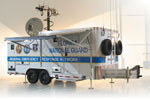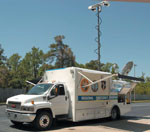Guard Ready for Emergencies
 |
| These over-the-road trailer platforms are part of the Regional Emergency Response Network being put into place by the Florida National Guard. The network will enable interoperable communications among Guard members, first responders and other government and military personnel. |
Hurricanes here, manmade trouble there, disasters, disasters everywhere. Between Mother Nature running amok and human-borne disasters,
The Florida Army National Guard is implementing a Regional Emergency Response Network with state-of-the-art technology to improve communications and command and control (C2) during disaster response. The network systems offer C2 capabilities, radio interoperability and the ability to pass radio transmissions between state and local agencies as well as the military. Wired, wireless and satellite connectivity are all available so information from the field can be disseminated and sent to network operations centers and other command areas.
The development of the network comes as a result of problems experienced during the 2004 and 2005 hurricane seasons. “Tactical assets available to the state of
The Florida Army National Guard resolved to fix the problems by procuring methods to provide commanders and other staff in the field with the same communications they enjoy at their office desks. The result of that effort is the Regional Emergency Response Network, which offers the Guard the capabilities it lacked in the past. “Number one, we can communicate,” Maj. Van Zant says.
The network expands the Guard’s presence in austere operating environments and provides reachback capabilities through satellite technology. It also offers radio suite capability that is tied into
According to developers, the new network offers capabilities never before available to Florida Guard troops. The spread spectrum capability, for instance, allows forces to communicate on multiple carriers simultaneously. Also, with the correct antenna and modem, users can access full video teleconferencing and voice-over Internet protocol features and can connect to local first-responder radios while travelling at speeds of up to 70 miles per hour. By fusing the different pieces, troops can receive real-time updates on the way to a disaster scene.
The network’s system units come with self-contained power and can operate for up to 96 hours with onboard fuel. They also provide external power to the tactical operations center of a supported command. With the systems, users can take advantage of two networks. The first is the Florida National Guard network, which allows Guard personnel to log in and use e-mail the same way they would in an office.
The second is a nonsecure network that can support Internet access for outside agencies. Through that, non-Guard personnel can launch their virtual private networks and access resources. In addition to containing the power to run the networks, the systems can plug into cell phone towers or other communications centers and provide power to them.
To enhance interoperability, all types of first responders can bring their radios, laptops and other communications devices to the trucks and trailers and program them to connect to the network. Mike Garvey is executive vice president of Applied Global Technologies (AGT) Federal, the communications systems contractor company and program manager for the effort. According to Garvey, the network is designed so the systems are agnostic to any capabilities on the market. “We cross-band all frequencies together so everyone is on one giant communications grid,” he explains. The systems include 20 to 40 of their own radios that owners can distribute as necessary.
The network will equip the Guard for the first time with the resources soldiers in the field have for minimum operations, and it should limit the amount of outside help that the state of
In the past, Guard troops had to employ workarounds to establish communications. Now, those same forces will have voice communications and other data that can pass from the command to the field and back. The impact on field reporting improves situational awareness at higher levels, allowing commanders to plan properly. Proper communications are especially important for Guard troops, who have less regular interaction than personnel at other agencies and active-duty military units.
 |
| The Florida National Guard’s Regional Emergency Response Network systems are designed on four different platforms including this truck-mounted-on-chassis version. A smaller truck version of the system can be airlifted. |
The equipment in the Regional Emergency Response Network is so advanced that a new signal company with the 53rd Infantry Brigade Combat Team—the largest National Guard unit in
The Guard has 16 systems as of July, configured on four different platforms: trailer-mounted, trailer-mounted with the ability to be loaded on a C-130 aircraft, truck-mounted on a chassis and a smaller truck version. Eight systems will be trailer-mounted. Troops will stabilize the trailers when they reach the desired set-up location and deploy the satellite dishes and antennas. The entire process takes about 45 minutes, after which forces have Internet protocol phones, wireless capabilities and the ability to support wired computers as well. “It comes with a base load of 10 phones and 10 computers to support the command,” Maj. Van Zant says.
The trailer platforms that can be loaded on a C-130 were being delivered and were untested at the time of publication. The truck-mounted systems on chassis have the same capabilities, but cannot be flown on aircraft.
The final platform, the smaller truck version, has fewer capabilities than its larger counterparts. Maj. Van Zant explains that the Guard took out the ultrahigh frequency (UHF) repeater “and a few of the other nice-to-have things,” but it can be driven onto a C-130 to be airlifted. The Guard also intends to obtain a sling load certification to move the smaller truck platform on a CH-47. This option is especially important for regions such as the
The various platform options are designed to enable Guard forces to react to any type of manmade or natural incident. “In
Because the network received 100 percent federal funding, the Guard can move it to another state to respond to other crises, hence the word regional in the title and the development of the air mobile solution. The Florida Guard will extend training to incorporate operators from other places, especially other southeastern states. According to the Emergency Management Assistance Compact (EMAC), southeastern states must assist one another in an emergency. In one example of that compact, the Florida Army National Guard sent forces, including combat search and rescue and special operations troops, as well as small systems, into Mississippi to assist with Hurricane Katrina in 2005.
A unique feature of the Regional Emergency Response Network procurement was the creation of a prototype system that the Guard adjusted to meet its needs. After the prototype, three production models were built. Then in phase two—which was funded concurrently with phase three—the Guard incorporated more upgrades and changes on three new platforms. The total 16 platforms will include groups of identical systems and the oddball prototype.
Several private companies worked on the total network development with the Guard. Contractor support included AGT, Digital Consulting Service (DCS), WolfCoach, Coleman Technologies Incorporated and Proactive Communications Incorporated (PCI). AGT is the primary builder/integrator along with Coleman. DCS is the prime on the air mobile systems along with WolfCoach and PCI. DCS and PCI are also working on the advanced satellite network capabilities via access to a fully meshed satellite network. Access is provided through a satellite hub station. In addition to offering voice, video and data for emergency response C2 operations, the satellite network provides a path for next-generation, communications-on-the-move capabilities.
According to Larry Hall, chief operating officer of PCI, his company built a network that has been optimized for a sub-one-meter satellite ground station. The satellites are on the Telsat constellation. Currently, a T-14 is employed, but Hall explains other satellites such as the Galaxy 27 could be used as well.
Another capability of the system is mesh networking, which allows remote nodes to communicate directly with one another without messages traveling through a main hub. “This really helps speed communications,” Hall says.
In addition, the network offers Federal Information Processing Standard 140-2 compliance. Teleport diversity is built into the architecture, which enables some redundancy at the teleport level. By locating some technology in other areas of the
Some of the technology being developed for the Florida National Guard is branching out to other states. Garvey says that the communications systems were used recently in the Tennessee National Guard-hosted Vigilant Guard 08 exercise. During the event, the network systems were used as the main communications capability. AGT also is building the systems for the Minnesota National Guard, which will use them to support the Republican National Convention in
Web Resources
Emergency Management Assistance Compact: www.emacweb.org




Comments